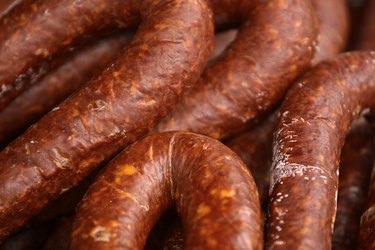
Recipes that call for spicy sausage often give the cook a choice between linguica or andouille. Both sausages are made from pork and a pungent mix of spices, so they share a similar flavor profile. Even so, there are important distinctions in the origin, ingredients and techniques for each sausage.
Origins
Video of the Day
Despite sharing some similar characteristics, linguica and andouille have very different histories. Linguica is a Portuguese specialty that is closely related to Spanish-style chorizo or Portuguese chouriҫo. It's also a prominent ingredient in Brazilian cuisine, reflecting influences from early Portuguese colonists in Brazil. Andouille sausage, on the other hand, has roots in Medieval France. French Acadians later brought the idea to the American South, where it developed into the smoky, Cajun-style sausage that is most common today.
Video of the Day
Ingredients
Both linguica and andouille are spicy pork sausages, but they contain marginally different blends of ingredients. Andouille traditionally includes chitterlings and tripe – pig intestines and stomach – though modern producers sometimes skip the offal. Linguica, by contrast, is a more standard mix of pork meat and chunks of pork fat. Linguica also features a heavy dose of garlic and spicy paprika, while andouille typically contains a mix of classic Cajun spices, including cayenne, sweet paprika and thyme.
Techniques
Linguica is a dry-cured sausage, which means that it is salted and hung to dry and harden before it comes to market. This process gives it a slightly firmer texture than andouille sausage, which is usually smoked rather than dry-cured. Some producers lightly smoke linguica after curing it, but andouille is more well-known for its smoky flavor. Linguica also has a rather slim width, compared to the more standard-sized andouille sausage.
Uses
Andouille and linguica are both sold ready to eat, without further cooking. Simply slice them into bite-size pieces for a spicy hors d'oeuvre. Both sausages are also essential to a variety of classic cooked dishes, such as Cajun gumbo with andouille and Portuguese caldo verde with linguica. If you need to substitute for one or the other, Spanish-style chorizo is a good choice, especially for linguica. They can also serve as comparable substitutes for each other.